◄ Carnets Geol. 16 (15) ►
Contents
[1. Introduction]
[2. Palaeontological study]
[Conclusion]
[Bibliographic references] and ... [Plates]
Centre d'Études Méditerranéennes, 04170 St
André les Alpes (France);
Département des Sciences de la Terre, Université de Nice-Sophia-Antipolis,
Faculté des Sciences, 28 avenue Valrose, 06108 Nice Cedex 2 (France)
Centre d'Études Méditerranéennes, 04170 Saint-André-les-Alpes (France);
16 rue Frédéric Mistral, 26200 Montélimar (France)
57 bis avenue des Patriotes, 26300 Bourg-de-Péage (France)
Centre d'Études Méditerranéennes, 04170 04170 Saint-André-les-Alpes (France);
39 Bd Émile Zola, La Toscane G25, 06130 Grasse (France)
Published online in final form (pdf) on July 7, 2016
[Editor:
Michel Moullade; technical editor: Bruno Granier;
language editor: Stephen Carey]
New investigations in the Vocontian Lower Aptian deposits resulted in the discovery of very rare specimens of heteromorphic ammonites whose specific morphological and ornamental features have led to the erection of Ivaldiceras gen. nov. Represented by a very limited number of specimens this new genus consists of two species: I. baratteroi gen. & sp. nov. and I. divajeuensis gen. & sp. nov. The suprageneric position of the new genus is difficult to determine because of the poor preservation of its sutural elements and the incomplete state of the specimens. The genus is tentatively assigned to the Family Macroscaphitidae Hyatt, 1900, pending the study of better preserved material.
Ammonoidea; Ivaldiceras gen. nov.; Lower Aptian; Lower Cretaceous; southeast France.
Delanoy G., Baudouin C., Boselli M. & Penagé E. (2016).- Ivaldiceras, a new genus of heteromorphic ammonites from the Lower Aptian of southeast France.- Carnets Geol., Madrid, vol. 16, no. 15, p. 369-381.
Ivaldiceras, un nouveau genre d'ammonites hétéromorphes de l'Aptien inférieur du Sud-Est de la France.- La poursuite des investigations dans les dépôts de l'Aptien inférieur vocontien a conduit à la découverte de très rares spécimens d'ammonites hétéromorphes dont les caractéristiques morphologiques et ornementales particulières ont amené à la création du genre Ivaldiceras gen. nov. Représenté par un nombre très restreint de spécimens ce nouveau genre est constitué de deux espèces : I. baratteroi gen. nov. sp. nov. et I. divajeuensis gen. nov. sp. nov. La position supragénérique de ce nouveau genre reste actuellement très difficile à préciser à cause de la très mauvaise conservation des éléments suturaux et de l'état incomplet des spécimens. Il est inclus avec doute dans la famille des Macroscaphitidae Hyatt, 1900 en attendant l'étude d'un matériel mieux conservé.
Ammonoidea ; Ivaldiceras gen. nov. ; Aptien inférieur ; Crétacé inférieur ; Sud-Est de la France.
For several years, systematic investigations have been conducted in the Lower Aptian deposits of southeast France in order to clarify the nature of the ammonite faunal assemblage and the biostratigraphic framework. The ammonite fauna collected shows significant quantitative differences between the main part of the sedimentary basin and its peripheries (Delanoy, 1995, 1997; Cecca et al., 1998, 1999; Ropolo & Gonnet, 1998; Ropolo et al., 1998a, 1998b, 1999, 2006, 2008; Delanoy et al., 2008a, 2008b; Pictet et al., 2009). In the pelagic facies, this fauna is scarce and often restricted to the taxa with a wide geographical and stratigraphical distribution (e.g., genera Pseudohaploceras Hyatt, 1900, Macroscaphites Meek, 1876, Lytoceras Suess, 1865) while the most biostratigraphically significant elements belonging to genera Deshayesites Kazansky, 1914, Procheloniceras Spath, 1923, and Cheloniceras Hyatt, 1903, are infrequent and/or poorly preserved making their biostratigraphical use difficult. At the same time these investigations revealed the presence of rare but very distinctive elements that allowed the creation of new taxa of generic rank, Taxyites (Delanoy et al., 2008b) and Ivaldiceras gen. nov.
The terminology used to
designate different
parts of the shell is that used by Vaíček
(1972) (Fig. 1 ![]() ). Measurements
are in mm and were carried out as shown in Fig. 1
). Measurements
are in mm and were carried out as shown in Fig. 1 ![]() .
.
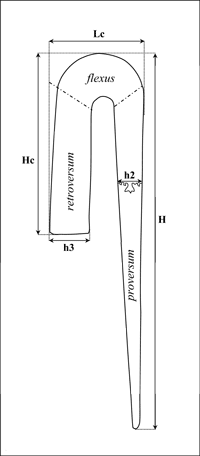
Click on thumbnail to enlarge the image.
Figure 1: Terminology and measured dimensions of shell used in this work.
Order Ammonoidea Zittel, 1884
Suborder Ammonitina Hyatt, 1889
? Superfamilly Ptychoceratoidea Gill, 1871
? Familly Macroscaphitidae Hyatt, 1900
Genus Ivaldiceras gen. nov.
Type-species : Ivaldiceras baratteroi gen. & sp. nov.
Derivatio nominis: The genus is dedicated to Jean Pierre Ivaldi, geologist and hydrogeologist at the University of Nice-Sophia Antipolis.
Diagnosis: Heteromorphic ammonite showing a hamuliniform coiling. The existence of an initial spiral part could not be observed. The proversum is straight, ornamented with fine single or bifurcated ribs and shows small tubercles arranged more or less regularly on the ribs or between the ribs. The flexus is closed and the retroversum is subparallel to the proversum. On the flexus the ribs thicken and converge toward conical or nodular tubercles. On the retroversum the ornamentation consists of ribs which may bear small tubercles on the edge of the dorsal and ventral regions.
Stratigraphic and geographic distribution: Ivaldiceras gen. nov. is known only from the Lower Aptian (Deshayesites oglanlensis and D. forbesi zones) of southeast France.
Comparison and discussion: The systematic position of the genus Ivaldiceras gen. nov. is currently difficult to determine due to the poor preservation of the specimens studied which prevents study of the suture lines. Within Acrioceratidae Vermeulen, 2004 (sensu Vermeulen et al., 2013) morphological similarities exist with the genera Dissimilites Sarkar, 1954, Hamiticeras Anderson, 1938, Toxoceratoides Spath, 1924, Artareites Bert, 2009, and with some species assigned to the genus Helicancylus Gabb, 1869. The generic position of the species of Helicancylus Gabb, should be reviewed if the latter is considered nomen dubium (Vermeulen, 2010; Vermeulen et al., 2013). Dissimilites Sarkar shows a morphology very similar to that of Ivaldiceras gen. nov., but the ornamentation of the proversum consists of alternate main trituberculate ribs and simple intermediary non-tuberculate ribs. Small tubercles are also present on the dorsal and/or the ventral regions of the retroversum. The stratigraphic position of the genus Dissimilites Sarkar is very different, confined to the Lower Barremian and lowermost Upper Barremian and ranging from the Nicklesia pulchella Zone to the Toxancyloceras vandenheckii Zone (Vermeulen, 2009; A. Lukeneder & S. Lukeneder, 2014).
Toxoceratoides Spath (Upper Barremian-Lower Aptian) shows ancyloceratic to toxoceratic coiling. The ornamentation on the proversum consists of a more or less regular alternation of main trituberculate ribs and intercalatory ribs, usually without tubercles or tuberculated on the periventral area. On the retroversum, ribs lack tubercles and originate in twos or threes from a small tuberculiform peridorsal bulge.
In Artareites Bert, ranging from the Upper Barremian (Toxancyloceras vandenheckii Zone) to the Lower Aptian (Deshayesites forbesi Zone) (Bert, 2009; Vermeulen, 2013), the ornamentation of the proversum is characterized by many fibulate ribs with a periventral tubercle. Trituberculate ribs, if present, can occur with the fibulate ribs. At least on the retroversum, ribs are simple or bifurcate from a peridorsal tubercle.
The genus Hamiticeras Anderson, present at various levels of the Aptian, is characterized by ornamentation similar to that of Toxoceratoides Spath on the proversum and simple ribs without tubercles on the retroversum.
Ornamental features characteristic of Ivaldiceras gen. nov. are also found in some Anahamulinidae Breistroffer, 1952, from the Lower Barremian such as Anahamulina lorioli (Uhlig, 1883) or A. davidsoni (Matheron, 1880), in which ornamental similarities exist on the retroversum. Similarly, Anahamulina suttneri (Uhlig, 1883) and Amorina hoheneggeri (Uhlig, 1883) show marked but brief strengthening of some ribs in the middle part of the flexus. The presence of strong ventral tubercles located in the same part of the shell is known in the genus Auritina Egoian, 1989, from the Lower Barremian (Kotetishvilia nicklesi Zone).
The genus Ptychohamulina Vermeulen, 2005 (= Pacaudina Vermeulen et al., 2010; = Badina Vermeulen & Vaíček 2011 in Baudouin et al., 2012) present in the Upper Barremian and Lower Aptian ("Bedoulian") consists of small shells whose proversum and retroversum are nearly parallel to subparallel, sometimes divergent. The ornamentation of the proversum and the retroversum is generally feeble and sometimes absent. Where present, the ribs are never tuberculate. The flexus is smooth and shows non-tuberculate ribs of weak relief while a thick, more or less elevated rib is often present. In P. coulleti Vermeulen et al., 2007, this localised strengthening of ribbing modifies the whorl section.
Duyeina glemmbachensis (Immel, 1987), ranging from the top of the Martelites sarasini Subzone to the base of the Deshayesites oglanlensis Zone, has a shell whose retroversum and proversum are parallel and very close to each other. The ornamentation is quite uniform and strong, consisting of simple, non-tuberculate, thick and annular ribs that branch on the flexus.
The genus Monodites Bert 2009 (Family Monoditidae Bert, 2009), although morphologically close to Ivaldiceras gen. nov., differs in that its ribbing is mainly composed of relatively strong ribs which are trituberculate on the proversum. In addition, its tuberculation tends to be attenuated on the flexus and the retroversum. Monodites Bert also differs from Ivaldiceras gen. nov. in its distinct stratigraphical position in the uppermost Hauterivian and Lower Barremian (Vermeulen et al., 1999; Bert, 2009).
The micromorphic genus Xerticeras Delanoy et al., 2013, is also characterized by a fairly uniform ribbing consisting of very fine, sharp ribs which may strengthen on the retroversum. It differs from Ivaldiceras gen. nov. in the lack of tubercles and in its aspinoceratic morphology (hamuliniform in Ivaldiceras gen. nov.). This taxon is present in the Lower Aptian Deshayesites deshayesi and Dufrenoyia furcata zones (Delanoy et al., 2013).
"Toxoceratoides" dietrichii Delanoy et al. (2008a) shows toxoceratid coiling (Aguirre Urreta, 1986) and ornamentation consisting of simple non-tuberculate ribs on the spire and the base of the proversum, which develop in pairs from large bullae in the peridorsal area of upper part of the proversum and at the beginning of the flexus. The bullae tend to disappear early in the retroversum where ribs are either simple or bifurcated from the peridorsal area.
Some morphological and ornamental characteristics of Ivaldiceras gen. nov., i.e., very fine more or less angular ribs and discrete tuberculation on the proversum and the retroversum, are present in some members of the Family Macroscaphitidae Hyatt, 1900, particularly among the microconch forms of genera Macroscaphites Meek, 1876, and Lytocrioceras Spath, 1924. However, none of these taxa shows Ivaldiceras's early strengthening of the ornamentation in the flexus. In the genus Epacrioceras Egoian, 1974, also assigned to the Macroscaphitidae (Vermeulen & Bulot, 2007; Klein et al., 2007), the tuberculated ribs are present only on the spire. The proversum is ornamented with fine, simple, non-tuberculated ribs; likewise on the flexus and the retroversum where the ribbing tends to thicken and peridorsal bifurcations seem to be present. Finally, Ivaldiceras gen. nov. shares most of its morphological and ornamental features with some representatives of the Macroscaphitidae Hyatt. Hence we tentatively include Ivaldiceras gen. nov. within the Family Macroscaphitidae Hyatt, 1900, pending the discovery of better preserved and more complete material.
Ivaldiceras baratteroi gen. & sp. nov.
Studied material: One specimen MNHN.F.A57290 coll. Barattero, deposited in the collections of the Muséum National d'Histoire Naturelle de Paris, from Lower Aptian, Deshayesites forbesi Zone, bed 266 from Tremolies section (Alpes de Haute-Provence, France).
Holotype: Specimen MNHN.F A57290 coll. Barattero, Lower Aptian, Deshayesites forbesi Zone, bed 266 from the Tremolies section (Alpes de Haute-Provence, France).
Derivatio nominis: Species dedicated to Xavier Barattero who discovered the holotype of this new taxon.
Locus typicus: Ravin de la Colle section, Tremolies, near the village of Moriez (Alpes de Haute-Provence, France).
Stratum typicum : Bed 266 of the Ravin de la Colle section.
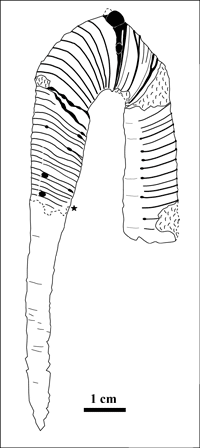
Click on thumbnail to enlarge the image.
Figure 2: Schematic representation of Ivaldiceras baratteroi gen. & sp. nov. The end of the phragmocone is indicated by a star.
Diagnosis: Ivaldiceras with more or less large conical tubercles in the middle of the flexus.
Measurements (mm):
Table 1: Measurements of Ivaldiceras baratteroi gen. & sp. nov.
| Specimen | H | Hc | Lc | h2 | h3 |
| MNHN.F.57290 | 94 | 53 | 36 | 10 | (ca 16)-19* |
* For h3, the measurement ca 16 mm is an estimate of the whorl height without allowing for post mortem compression of the specimen. The total observed height including deformation is 19 mm.
Description
The incomplete proversum and retroversum are the only preserved elements. The shell, affected by strong post-mortem compression, shows hamuliniform coiling.
The lower half of the preserved proversum corresponds to the limonitized phragmocone; no ornamentation is distinguishable except for numerous poorly preserved fine ribs.
The upper part of the proversum, corresponding to the beginning of the body chamber, shows numerous thin, sharp ribs, regularly spaced and crossing the flanks and venter with uniform thickness.
At the very beginning of the body chamber, on the assumed periventral area, tiny tubercles with minimal relief are located between two ribs that they connect. Fine intercalatory ribs are arranged between these groups of ribs/tubercles. Distally, the tubercles disappear and the last part of the proversum, just before the flexus, shows a small number of very small tubercles irregularly arranged on the ribs and at different heights on the lower half of the sides, but rarely along the ventral area.
The flexus shows significant changes in ornamentation. In its first half, ornamentation is similar to that of the proversum but the ribbing is stronger. The regularly spaced simple ribs thicken gradually towards and on the ventral region. A pair of strong ribs, thicker than the previous ones, appears in the middle of the flexus. The strongest, located aborally, bears a lateral tubercle that extends radially towards mid-flank. The two ribs merge on the ventral area to form a large, more or less conical tubercle along the ventral axis. Thus, two such tubercles occur on either side of the ventral axis.
On the second half of the flexus, major ribs thickening and branching on the upper third of the flanks alternate with thinner intercalary ribs mainly on the upper third of the flanks.
The retroversum shows uniform ribbing consisting of simple, relatively thick ribs of uniform thickness, all originating from a tiny peridorsal tubercle. The ribs cross the venter with a small tuberculiform swelling on the periventral area. Thinner, irregularly arranged, intercalary ribs are also present. The dorsal region shows extremely fine costules.
The peristome is not preserved.
The sutures cannot be studied because their very poorly state of preservation.
Comparison and discussion:
Ivaldiceras baratteroi gen. & sp. nov. was
collected in the Deshayesites forbesi Zone of Tremolies
section, located near the village of
Moriez (Alpes de Haute Provence, France). The section was described
by Delanoy (1995, 1997) and includes the limestone beds of the Deshayesites oglanlensis Zone
and
of the D. forbesi
Zone. The latter biostratigraphic unit is incomplete due
to a significant gap between the top of the "Bedoulian" calcareous series and
the
beginning of the thick "Formation
des Marnes Bleues". The base of the Dufrenoyia furcata Zone, characterized
by the "Niveau Blanc", starts
at about 3 meters above the top of
the last limestone bed. The stratigraphic position of Ivaldiceras baratteroi
gen. & sp. nov. is
nevertheless confirmed by the presence in
bed 263 of Deshayesites
aff. euglyphus
Casey, 1964 (Pl. 1 ![]() , fig. 3).
, fig. 3).
Ivaldiceras baratteroi gen. & sp. nov. shares, on the flexus, great ornamental similarities with Auritina aurita Egoian, 1989. The type species of the genus Auritina Egoian, 1989, described for the first time in the Western Caucasus (Egoian, 1989), is indeed characterized by the presence of two very strong tubercles in the same part of the shell. Nevertheless A. aurita Egoian differs from Ivaldiceras baratteroi gen. & sp. nov. in the presence of fine, dense ribbing without tubercles on the proversum and on the retroversum which are subparallel and almost contiguous.
The
two taxa also differ
in their very different stratigraphic positions.
A. aurita Egoian is
known only in the Lower Barremian
Kotetisvilia nicklesi Zone. According
to Vermeulen (2009), the
genus Auritina
Egoian has been founded on teratological specimens but the discovery of
several specimens in the
Kotetisvilia nicklesi Zone of southeast France (Pl. 1 ![]() , fig.
2)
confirms the validity of the genus
which probably originates from
the Anahamulinidae with reinforced ribbing in the flexus
such as Amorina hoheneggeri (Uhlig, 1883) or Anahamulina suttneri
(Uhlig, 1883). This last species was tentatively assigned to the new genus
Auritina
by Egoian (1989).
, fig.
2)
confirms the validity of the genus
which probably originates from
the Anahamulinidae with reinforced ribbing in the flexus
such as Amorina hoheneggeri (Uhlig, 1883) or Anahamulina suttneri
(Uhlig, 1883). This last species was tentatively assigned to the new genus
Auritina
by Egoian (1989).
Comparison with I. divajeuensis gen. & sp. nov. follows below.
Stratigraphic and geographic distribution: Ivaldiceras baratteroi gen. & sp. nov. is known only from the Lower Aptian of southeast France, in the Deshayesites forbesi Zone.
Ivaldiceras divajeuensis gen. & sp. nov.
Material studied: One specimen no. div06, coll. Boselli, Lower Aptian, Deshayesites oglanlensis Zone, Deshayesites luppovi horizon, bed 10, Divajeu section A (Drôme, France). A cast is deposited in the collections of the Muséum National d'Histoire Naturelle de Paris under the no. MNHN.F. A57291.
Holotype: Specimen no. div06, coll. Boselli, Lower Aptian, Deshayesites oglanlensis Zone, Deshayesites luppovi horizon, bed 10, Divajeu section A (Drôme, France).
Derivatio nominis: From the name of the village of Divajeu (Drôme, France).
Locus typicus: Divajeu section A (Drôme, France).
Stratum typicum: Bed 10 of the Divajeu section A.
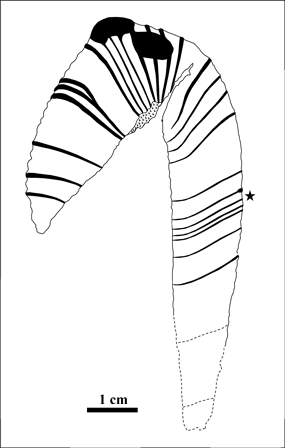
Click on thumbnail to enlarge the image.
Figure 3: Schematic representation of Ivaldiceras divajeuensis gen. & sp. nov. The end of the phragmocone is indicated by a star.
Diagnosis: Ivaldiceras characterized by the presence of large nodular and flattened tubercles situated on the flexus, one on the venter and two others on the periventral area.
Measurements (mm):
Table 2: measurements of Ivaldiceras divajeuensis gen. & sp. nov.
| Specimen | H | Hc | Lc | h2 | h3 |
| div06 | 83 | 47.5 | 42.5 | 13 | -- |
Description: The specimen is incomplete, the early ontogenic stages and the lower part of the proversum missing. The partial phragmocone, calcitized and poorly preserved, corresponds to the lower part of the proversum. However, numerous thin, prorsiradiate ribs can be distinguished, though no detail can be distinguished.
The body chamber begins in the upper part of the proversum. Until the beginning of the flexus it is oval in section, wider than high (W/H = 19/13 = 1.46). The flanks are convex and the ventral and dorsal regions are convex and broad. The ornamentation consists almost exclusively of numerous, very fine, simple, slightly sinuous, prorsiradiate ribs. They are equally thick across the dorsal and ventral regions as on the sides. At the beginning of the body chamber, a rib thickens strongly in the upper third of the flanks and forms an inconspicuous flat tubercle extended radially on the ventro-lateral border.
On the flexus the ornamentation shows significant changes. At its beginning, we observe simple, somewhat sinuous ribs which thicken from the dorsal region to the ventral area. Around the middle of the flexus, three thicker ribs appear that bear, in the upper third of the flanks, a very large nodular, flattened, more or less circular tubercle straddling these ribs. On the venter, the three thick ribs connect the two tubercles located on each side of the ventral area. In front of this group of ribs/tubercles, riblets converge towards a big nodular tuberculiform bulge located in the middle of the ventral area, slightly forward of the previously described tubercles.
The retroversum is incomplete. However, it shows uniform ornamentation, generally consisting of simple ribs except on the end of the flexus where rare bifurcations can be observed in the upper part of the flanks. All these ribs are sharp and cross the broad ventral area.
The peristome is not preserved.
Sutures cannot be studied because their very poorly state of preservation.
Comparison and
discussion:
Ivaldiceras divajeuensis gen. & sp. nov. was discovered in a very small outcrop situated near
the quarry of Trois-Vernes (Fig. 4 ![]() ), which delivered a rich ammonite fauna from
the uppermost Barremian/lowermost Aptian (Delanoy et al.,
2008a).
), which delivered a rich ammonite fauna from
the uppermost Barremian/lowermost Aptian (Delanoy et al.,
2008a).
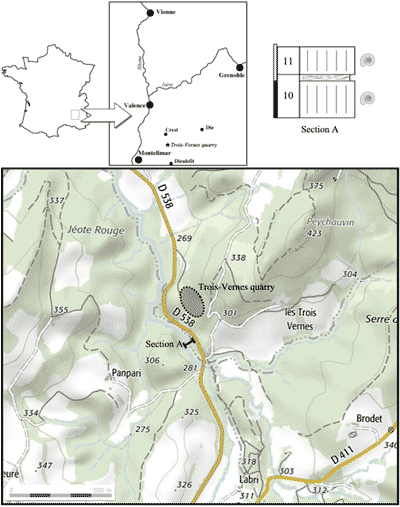
Click on thumbnail to enlarge the image.
Figure 4: Location of section A near the Trois-Vernes quarry.
Unfortunately,
lithological continuity between the
quarry and the outcrop is not observed but the fauna collected from
the outcrop demonstrates that
it exposes levels stratigraphically above those of the quarry. Indeed,
the presence in bed 10 of Procheloniceras aff. stobiesckii (Orbigny,
1850) (Pl. 2 ![]() ,
fig. 2), Deshayesites aff. luppovi
Bogdanova, 1983 (Pl. 1
,
fig. 2), Deshayesites aff. luppovi
Bogdanova, 1983 (Pl. 1 ![]() , figs. 4-5), Eulytoceras
phestum (Matheron,
1880) and Macroscaphites yvani
(Puzos, 1832) [M] indicate clearly that this
level belongs
to the Deshayesites oglanlensis Zone. Bed 11 yielded only Procheloniceras
aff. stobiesckii
(Orbigny)
and Eulytoceras phestum
(Matheron).
, figs. 4-5), Eulytoceras
phestum (Matheron,
1880) and Macroscaphites yvani
(Puzos, 1832) [M] indicate clearly that this
level belongs
to the Deshayesites oglanlensis Zone. Bed 11 yielded only Procheloniceras
aff. stobiesckii
(Orbigny)
and Eulytoceras phestum
(Matheron).
Ivaldiceras divajeuensis gen. & sp. nov. is close to I. baratteroi gen. & sp. nov. from which it differs in its three large nodular bulges situated on the flexus, whereas I. baratteroi gen. & sp. nov. shows two well developed conical tubercles on the same part of the shell. The ribbing shows great similarities between the two species but in I. divajeuensis gen. & sp. nov., the ribs are a little thicker and more sinuous, especially on the upper part of the proversum and on the retroversum. Furthermore, the little tubercles observed in I. baratteroi gen. & sp. nov. are rare or absent on the beginning of the body chamber and absent from the preserved part of the retroversum. In addition, the two species have different stratigraphic positions: Deshayesites oglanlensis Zone for Ivaldiceras divajeuensis gen. & sp. nov. and D. forbesi Zone for I. baratteroi gen. & sp. nov.
Stratigraphic and geographic distribution: Ivaldiceras divajeuensis gen. & sp. nov. is known only in the Lower Aptian Deshayesites oglanlensis Zone of southeast France.
The description of the genus Ivaldiceras gen. nov. and the species I. divajeuensis gen. & sp. nov. and I. baratteroi gen. & sp. nov. completes the inventory of heteromorphic ammonite fauna of the Lower Aptian of the Vocontian Basin. This study advances our knowledge of these rare taxa whose systematic position of suprageneric rank remains very uncertain. The assignment of Ivaldiceras gen. nov. to the Family Macroscaphitidae Hyatt, 1900, is based on morphological and ornamental criteria common in some representatives of this family. Only the collection of more complete specimens, particularly ones that allow the study of the suture patterns, will clarify the systematic position of the genus and its phylogenetic relationships.
We thank particularly M. Xavier Barratero (Centre d'Études Méditerranéennes) for the study of his material, and J.A. Moreno Bedmar (Universidad Nacional Autónoma de México) for his pertinent opinions on the Deshayesitidae. We also thank the management of the Réserve Géologique de Haute Provence who allowed the fieldwork on their territory. Finally, we warmly thank the reviewers, Mikhail Kakabadze (A. Djanelidze Institute of Geology, Tbilisi, Georgia), J.A. Moreno Bedmar, for their constructive remarks and Stephen P. Carey (Federation University, University of Ballarat, Australia) for the improvement of the English text.
Aguirre-Urreta M.B. (1986).- Aptian ammonites from the Argentinian Austral basin. The Subfamily Helicancylinae Hyatt, 1900.- Annals of the South African Museum, Cape Town, vol. 96, no. 7, p. 271-314.
Baudouin C., Delanoy G., Boselli P., Bert D. & Boselli M. (2012).- Les faunes d'ammonites de la Sous-zone à Sarasini (Barrémien supérieur) dans les Baronnies (Drôme, France).- Revue de Paléobiologie, Genève, vol. 31, no. 2, p. 601-677 (15 Pls.).
Bert D. (2009).- Description de Artareites landii nov. (Ammonoidea) du Barrémien supérieur de Majastre (Sud-Est de la France) et discussion sur les Helicancylidae Hyatt, 1894.- Annales de Paléontologie, Paris, vol. 95, p. 139-163 (3 Pls.).
Cecca F., Ropolo P. & Gonnet R. (1998).- La base de l'Aptien à Cassis-La Bédoule (SE France).- Géologie Méditerranéenne, Marseille, t. XXV, no. 3-4, p. 149-157 (2 Pls.).
Cecca F., Ropolo P. & Gonnet R. (1999).- The appearance of the genus Deshayesites (Kazansky, 1914, Ammonoidea) in the lowermost Aptian (Lower Cretaceous) of La Bédoule (SE France).- Rivista Italiana di Paleontologia e Stratigrafia, Milan, vol. 105, no. 2, p. 267-286 (9 Pls.).
Delanoy G. (1995).- About some significant Ammonites from the Lower Aptian (Bedoulian) of the Angles-Barrême area (South-East of France). In: Cecca F. (ed.), Proceeding of 3rd Workshop on Early Cretaceous Cephalopods.- Memorie descrittive della Carta Geologica d'Italia, Roma, vol. 51, p. 65-101 (10 Pls.).
Delanoy G. (1997).- Biostratigraphie des faunes d'Ammonites à la limite Barrémien-Aptien dans la région d'Angles-Barrême-Castellane. Étude particulière de la Famille des Heteroceratidae (Ancyloceratina, Ammonoidea).- Annales du Muséum d'Histoire Naturelle de Nice, vol. 12, 270 p. (62 Pls.).
Delanoy G., Baudouin C., Gonnet R. & Bert D. (2008a).- Sur les faunes d'ammonites (Crétacé inférieur) du niveau glauconieux de la carrière des Trois-Vernes, près de Crest (Drôme, sud-est de la France).- Annales du Muséum d'Histoire Naturelle de Nice, vol. 23, p. 11-65 (12 Pls.).
Delanoy G., Madou E., Penagé E., Baraterro X. & Lhaumet G. (2008b).- Taxyites nov. gen. un nouveau genre d'ammonite hétéromorphe de l'Aptien inférieur du sud-est de la France (Ammonoidea, Ancyloceratina).- Annales du Muséum d'Histoire Naturelle de Nice, vol. 23, p. 1-9 (1 Pl.).
Delanoy G., Moreno-Bedmar J.A., Ruiz J.J. & Tolós Lládser D. (2013).- Xerticeras gen. nov., a new genus of micromorphic heteromorph ammonite (Ancyloceratina, Ancyloceratidae) from the Lower Aptian of Spain.- Carnets Geol., Madrid, vol. 13, no. A02 (CG2013_A02), p. 89-103 (4 Pls.).
Egoian V. (1989).- New Lower Barremian ammonites from western Caucasus. Palaeontological method in practical stratigraphy.- Akademiya Nauk SSSR, Moscow, p. 135-145 (2 Pls.) [in Russian].
Klein J., Busnardo R., Company M., Delanoy G., Kakabadze M.V., Reboulet S., Ropolo P., Vaíček Z. & Vermeulen J. (2007).- Lower Cretaceous Ammonites III. Bochianitoidea, Protancyloceratoidea, Ancyloceratoidea, Ptychoceratoidea, p. 1-381. In: Riegraf W. (ed.), Fossilium catalogus I: Animalia, Pars 144.- Backhuys Publishers, Leiden.
Lukeneder A. & Lukeneder S. (2014).- The Barremian heteromorph ammonite Dissimilites from northern Italy: Taxonomy and evolutionary implications.- Acta Palaeontologica Polonica, Warsaw, vol. 59, no. 3, p. 663-680.
Pictet A., Delanoy G., Baudouin C. & Boselli P. (2009).- Le genre Lithancylus Casey, 1960 (Ammonoidea, Ancyloceratina) dans l'Aptien inférieur du Couloir rhodanien (Drôme, Sud-Est de la France).- Revue de Paléobiologie, Genève, vol. 28, no. 2, p. 491-509 (4 Pls.).
Ropolo P. & Gonnet R. (1998).- A propos de quelques Ancyloceratidae nouveaux ou peu connus du Barrémien sommital de la Bédoule (B. du Rh. - France) : Position stratigraphique et systématique.- Géologie Méditerranéenne, Marseille, t. XXV, no. 2, p. 117-143 (5 Pls.).
Ropolo P., Gonnet R. & Conte G. (1998a).- Le genre Pseudocrioceras dans les couches de passage du Barrémien supérieur/Bédoulien inférieur de Cassis-la Bédoule (SE France).- Géologie Méditerranéenne, Marseille, t. XXV, no. 3-4, p. 85-123 (10 Pls.).
Ropolo P., Gonnet R. & Conte G. (1998b).- Les Deshayesites de la Zone à Tuarkyricus dans l'Aptien inférieur de Cassis-La-Bédoule (SE France).- Géologie Méditerranéenne, Marseille, t. XXV, no. 3-4, p. 125-147 (7 Pls.).
Ropolo P., Gonnet R. & Conte G. (1999).- The 'Pseudocrioceras interval' and adjacent beds at La Bédoule (SE France): Implications to highest Barremian-lowest Aptian biostratigraphy.- Scripta Geologica Special Issue, Leiden, vol. 3, p. 159-213 (19 Pls.).
Ropolo P., Moullade M., Gonnet R., Conte G. & Tronchetti G. (2006).- The Deshayesitidae Stoyanov, 1949 (Ammonoidea) of the Aptian historical stratotype region at Cassis-La Bédoule (SE France).- Carnets Geol., Madrid, vol. 6, no. M01 (CG2006_M01), 46 p. (14 Pls.).
Ropolo P., Conte G., Moullade M., Tronchetti G. & Gonnet R. (2008).- The Douvilleiceratidae (Ammonoidea) of the Lower Aptian historical stratotype area at Cassis-La Bédoule (SE France).- Carnets Geol., Madrid, vol. 8, no. M03 (CG2008_M03), 60 p. (24 Pls.).
Vaíček Z. (1972).- Ammonoidea of the Tĕín-Hradite Formation (Lower Cretaceous) in the Moravskoslezske Beskydy Mts.- Vydal Ustreni ustav Geologicky, Praha, y Academii nakladatelstvi Ceskolovenské Akademie ved., p. 1-103 (16 Pls.).
Vermeulen J. (2009).- Ammonites nouvelles (Ancyloceratoidea) du Barrémien inférieur du Sud-Est de la France.- Riviéra Scientifique, Nice, p. 49-64 (1 Pl.).
Vermeulen J. (2010).- Sur les familles des Helicancylidae Hyatt, 1894 et des Acrioceratidae Vermeulen, 2004 ; réponses et précisions apportées au travail de Bert, 2009.- Annales de Paléontologie, Paris, vol. 96, p. 61-65.
Vermeulen J. & Bulot L. (2007).- Données nouvelles sur la classification phylogénétique des ammonites du Crétacé inférieur.- Annales du Muséum d'Histoire naturelle de Nice, vol. 22, p. 101-112.
Vermeulen J., Thieuloy J.-P. & Lapeyre J.-F. (1999).- Hamiticeras crevolai sp. nov. (Ammonoidea, Ancyloceratina), de l'Hauterivien supérieur du Sud-Est de la France.- Riviéra Scientifique, Nice, p. 79-84 (1 Pl.).
Vermeulen J., Lazarin P., Lepinay P., Leroy L. & Mascarelli E. (2013).- Taxa d'ammonites nouveaux ou peu connus de l'Hauterivien et du Barrémien du Sud-Est de la France.- Strata, Gaillac, (série 2), Mémoires, vol. 48, 58 p.
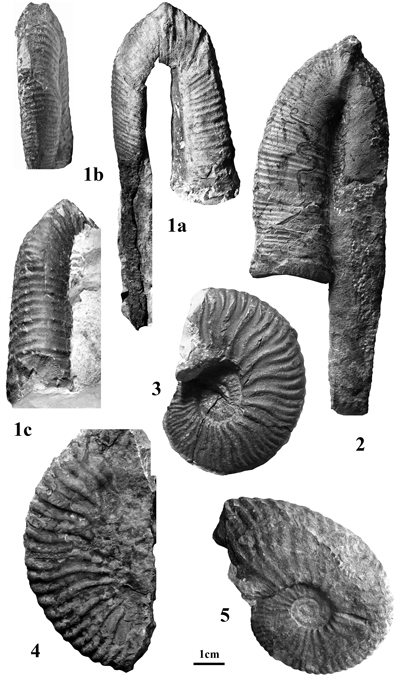
Click on thumbnail to enlarge the image.
Fig. 1: Ivaldiceras baratteroi gen. nov. sp. nov: holotype, ech. no. MNHN.F.A57290, coll. Barattero, Lower Aptian, Deshayesites forbesi Zone, bed 266 from Tremolies section (Alpes de Haute-Provence, France). 1a: lateral view; 1b: ventral view of the upper part of the proversum; 1c: view of the other side of the retroversum showing the preserved little tubercles.
Fig. 2: Auritina aurita Egoian, 1989: ech. no. Arp01, coll. Baudouin, Lower Barremian, Kotetisvilia nicklesi Zone, Arpavon (Drôme, France).
Fig. 3: Deshayesites aff. euglyphus Casey, 1964: ech. no. XB.TRE03, coll. Barattero, Lower Aptian, Deshayesites forbesi Zone, bed 266 from Tremolies section (Alpes de Haute-Provence, France).
Fig. 4: Deshayesites aff. luppovi (Bogdanova, 1983): specimen no. dvj2-03, coll. Baudouin, Lower Aptian, Deshayesites oglanlensis Zone, bed 10, Divajeu section A (Drôme, France).
Fig. 5: Deshayesites aff. luppovi (Bogdanova, 1983), specimen no. div04, coll. Boselli, Lower Aptian, Deshayesites oglanlensis Zone, bed 10, Divajeu section A (Drôme, France).
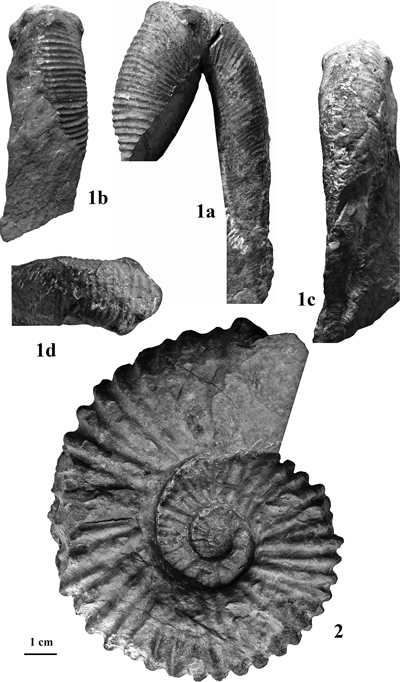
Click on thumbnail to enlarge the image.
Fig. 1: Ivaldiceras divajeuensis gen. nov. sp. nov. : specimen no. div06, coll. Boselli, Lower Aptian, Deshayesites oglanlensis Zone, Deshayesites luppovi horizon, bed 10, Divajeu section A (Drôme, France). 1a: lateral view; 1b: ventral view of the proversum; 1c: ventral view of the retroversum; 1d: ventral view in the flexus.
Fig. 2: Procheloniceras aff. stobieckii (Orbigny, 1850): specimen no. div01, coll. Boselli, Lower Aptian, Deshayesites oglanlensis Zone, bed 10, Divajeu section A (Drôme, France).